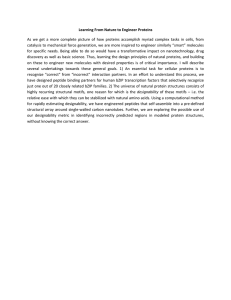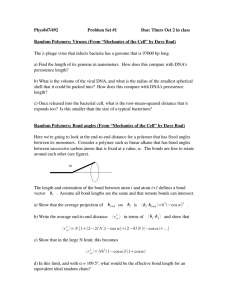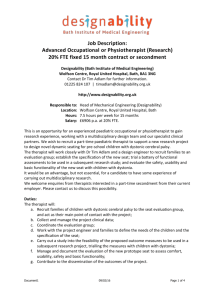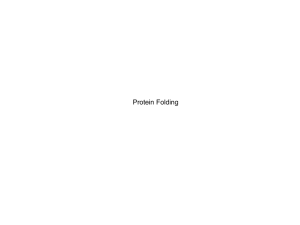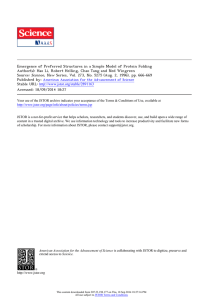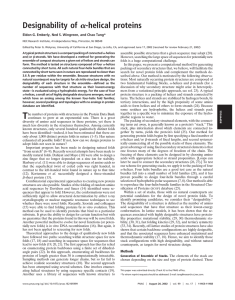Identifying Proteins of High Designability Via Surface-Exposure Patterns
advertisement
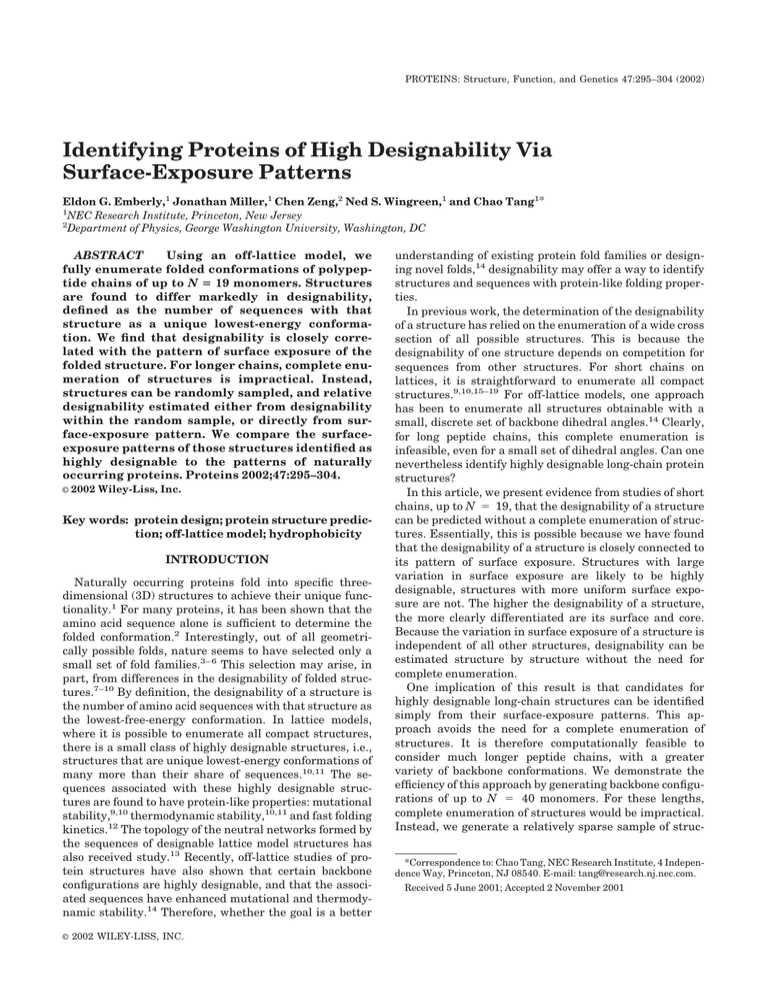
PROTEINS: Structure, Function, and Genetics 47:295–304 (2002) Identifying Proteins of High Designability Via Surface-Exposure Patterns Eldon G. Emberly,1 Jonathan Miller,1 Chen Zeng,2 Ned S. Wingreen,1 and Chao Tang1* 1 NEC Research Institute, Princeton, New Jersey 2 Department of Physics, George Washington University, Washington, DC ABSTRACT Using an off-lattice model, we fully enumerate folded conformations of polypeptide chains of up to N ⴝ 19 monomers. Structures are found to differ markedly in designability, defined as the number of sequences with that structure as a unique lowest-energy conformation. We find that designability is closely correlated with the pattern of surface exposure of the folded structure. For longer chains, complete enumeration of structures is impractical. Instead, structures can be randomly sampled, and relative designability estimated either from designability within the random sample, or directly from surface-exposure pattern. We compare the surfaceexposure patterns of those structures identified as highly designable to the patterns of naturally occurring proteins. Proteins 2002;47:295–304. © 2002 Wiley-Liss, Inc. Key words: protein design; protein structure prediction; off-lattice model; hydrophobicity INTRODUCTION Naturally occurring proteins fold into specific threedimensional (3D) structures to achieve their unique functionality.1 For many proteins, it has been shown that the amino acid sequence alone is sufficient to determine the folded conformation.2 Interestingly, out of all geometrically possible folds, nature seems to have selected only a small set of fold families.3– 6 This selection may arise, in part, from differences in the designability of folded structures.7–10 By definition, the designability of a structure is the number of amino acid sequences with that structure as the lowest-free-energy conformation. In lattice models, where it is possible to enumerate all compact structures, there is a small class of highly designable structures, i.e., structures that are unique lowest-energy conformations of many more than their share of sequences.10,11 The sequences associated with these highly designable structures are found to have protein-like properties: mutational stability,9,10 thermodynamic stability,10,11 and fast folding kinetics.12 The topology of the neutral networks formed by the sequences of designable lattice model structures has also received study.13 Recently, off-lattice studies of protein structures have also shown that certain backbone configurations are highly designable, and that the associated sequences have enhanced mutational and thermodynamic stability.14 Therefore, whether the goal is a better © 2002 WILEY-LISS, INC. understanding of existing protein fold families or designing novel folds,14 designability may offer a way to identify structures and sequences with protein-like folding properties. In previous work, the determination of the designability of a structure has relied on the enumeration of a wide cross section of all possible structures. This is because the designability of one structure depends on competition for sequences from other structures. For short chains on lattices, it is straightforward to enumerate all compact structures.9,10,15–19 For off-lattice models, one approach has been to enumerate all structures obtainable with a small, discrete set of backbone dihedral angles.14 Clearly, for long peptide chains, this complete enumeration is infeasible, even for a small set of dihedral angles. Can one nevertheless identify highly designable long-chain protein structures? In this article, we present evidence from studies of short chains, up to N ⫽ 19, that the designability of a structure can be predicted without a complete enumeration of structures. Essentially, this is possible because we have found that the designability of a structure is closely connected to its pattern of surface exposure. Structures with large variation in surface exposure are likely to be highly designable, structures with more uniform surface exposure are not. The higher the designability of a structure, the more clearly differentiated are its surface and core. Because the variation in surface exposure of a structure is independent of all other structures, designability can be estimated structure by structure without the need for complete enumeration. One implication of this result is that candidates for highly designable long-chain structures can be identified simply from their surface-exposure patterns. This approach avoids the need for a complete enumeration of structures. It is therefore computationally feasible to consider much longer peptide chains, with a greater variety of backbone conformations. We demonstrate the efficiency of this approach by generating backbone configurations of up to N ⫽ 40 monomers. For these lengths, complete enumeration of structures would be impractical. Instead, we generate a relatively sparse sample of struc*Correspondence to: Chao Tang, NEC Research Institute, 4 Independence Way, Princeton, NJ 08540. E-mail: tang@research.nj.nec.com. Received 5 June 2001; Accepted 2 November 2001 Published online 00 Month 2002 in Wiley InterScience (www.interscience.wiley.com). DOI: 10.1002/prot.10067 296 E.G. EMBERLY ET AL. tures. From the sample, it is straightforward to select the candidate highly designable conformations as those with the most clearly delineated surfaces and cores. An effectively equivalent procedure is to calculate designability, allowing only the structures in the sparse sample to compete for sequences. In either case, successful prediction of designability relies on its close relation to surfaceexposure variation—a property of individual structures. There is one important caveat to this point—two structures with very similar patterns of surface exposure will compete for structures often in a “winner-take-all” fashion. The implications of this for design are discussed under Results and Discussion, on random sampling. The results of the off-lattice model motivate us to consider the surface-exposure pattern of natural protein structures. We report a study of the surface-exposure pattern of backbones of up to length N ⫽ 75 from the Protein Data Bank (PDB). For small proteins, which are often stabilized by disulfide bonds and salt bridges, there is often no clearly delineated core. In contrast, for large proteins, the core is uniformly well defined with little variation from structure to structure. The most highly designable configurations generated using our sampling technique have patterns of surface exposure that fall within the range of naturally occurring proteins. Fig. 1. Depiction of a 19mer structure, constructed using the three (, ) angle pairs described in the text. The amino acid side groups are modeled by self-avoiding spheres of radius 1.9 Å centered on the C positions. MODELS AND METHODS The designability of a structure is a measure of how many sequences “fold” into that structure in relation to all other competing structures. Precise determination of designability requires generating a comprehensive set of structures, which then compete as possible lowest-energy states for amino acid sequences. It is only truly feasible to generate a complete set of model structures for short polypeptide chains. For larger chains, say with N ⬎ 30 monomers, it is not currently possible to enumerate structures. However, it will be shown that it is possible to estimate the designability of structures without complete enumeration. To find the best means of estimating designability, we study short chains (N ⫽ 15, 17, and 19) for which designability can be precisely determined within an off-lattice model. This section reviews our model for obtaining the designabilities of short-chain polypeptide structures. In the next section, we show that the designability of a structure within this model can be estimated from its surface-exposure pattern. Off-Lattice Model Our method of generating structures is closely related to the discrete-angle models introduced by Park and Levitt.14,20 For short polypeptide chains of N ⫽ 15, 17, and 19 monomers, a “complete” set of backbones is generated, using a fixed set of three dihedral (, ) angles.20 For this particular study, we employ one angle pair (⫺60, ⫺50) from the ␣-helical region of a Ramachandran plot, and two angle pairs (⫺140, 150) and (⫺65, 125) from the -strand region. The complete set of 3N backbones is generated with these angles. To restrict our consideration to self-avoiding structures, we introduce “side groups” by hard spheres of radius r ⫽ 1.9 Å centered on the C positions. Self-avoidance is taken into account by discarding all structures with overlapping spheres. The percentage of self-avoiding structures out of the possible 3N structures was found to be 42% for N ⫽ 15, 36% for N ⫽ 17, and 31% for N ⫽ 19. An example of a structure generated using the three angle pairs and with self-avoiding spheres centered on the C positions is shown in Figure 1. Hydrophobicity Model There is considerable evidence that hydrophobic forces are primarily responsible for the folding of an amino acid sequence into a particular structure.21–23 The hydrophobicity of each type of amino acid can be determined experimentally.24 –26 Those that are more hydrophobic are energetically favored to reside in the core of the folded protein, where there is low exposure to water. In a given folded protein, a hydrophobic energy can be assigned to each particular amino acid according to its hydrophobicity and exposure to water. To determine the hydrophobic energy of an amino acid sequence folded into one of our model structures, it is necessary to determine the exposure of each residue along the backbone. As described above, hard spheres are placed on each C position, and the surface exposure of these spheres to water is evaluated. This is done using the method of Shrake and Rupley,27 which determines how much of a sphere centered on a C position is exposed to a water molecule, represented as a sphere with a radius of 1.4 Å. We use the notation that the jth residue of the ␣th structure has accessible surface area a␣j . The sum of these surface areas gives the total residue accessible surface HIGH DESIGNABILITY VIA SURFACE-EXPOSURE PATTERNS 297 area for a given structure. As a screen, we use this quantity to remove those structures that have too much surface exposure and thus are too open to be stable folds. In practice, we reduce the representative set to approximately 5,000 structures with the least exposed surface area. The discarded structures are too open to have well-defined cores and therefore have low designabilities, as discussed in Results and Discussion. These remaining structures are “compact” in that, even for the small peptide chains used in this study (N ⫽ 15, 17, and 19), there is the beginning of the formation of a core that is inaccessible to solvent. We then normalize the surface area of the remaining compact structures using the following normalization condition: âj␣ ⫽ aj␣ 冘 aj␣ (1) j The motivation behind this normalization procedure is that our goal is for all the remaining compact structures to be equally compact—the normalized structures all have the same total surface exposure (¥jã␣j ⫽ 1). This is in line with lattice studies in which all structures are equally compact.9 –11 The normalization eliminates the need for an overall compactification energy in the energy function used below because all structures are equally compact. Physically, the use of equally compact structures accounts for the tendency of each structure to relax to its best packed equivalent. With the residue-by-residue surface areas of a set of compact, self-avoiding structures in hand, all that is needed is a hydrophobic-energy function to associate these structures with amino acid sequences. We find it convenient to assign a polarity between 0.0 and 1.0 to each amino acid, with 0.0 highly hydrophobic and 1.0 highly polar. Our notation is that the jth amino acid of a sequence  has polarity pj . In our model, the energy of this amino acid sequence when folded into the ␣th structure is11,28,29 E,␣ ⫽ ⫺ 冘 pjãj␣ (2) j For a given sequence, the lowest-energy structure is the one that minimizes this energy. Note that because all structures have the same total exposed surface (¥jã␣j ⫽ 1), a sequence will have lowest energy on the structure that best matches its pattern of hydrophobicity—more hydrophobic at core sites, more polar at surface sites—independent of the absolute hydrophobicity or polarity of the sequence. Designability The designability of a given structure is defined as the number of sequences with that structure as a unique lowest-energy conformation.10 We assess the designabilities of structures by evaluating the energy (2) of a large number of random sequences of polarities on all the structures in the representative set. Each sequence of polarities pj is generated as a string of N random real Fig. 2. Schematic diagram of fold space. Black circles correspond to vectors of exposed surface area ã for individual structures. Because the surface-area vectors are normalized, all lie on a single hyper-plane. The vector for uniform exposed area n ⫽ (1/N, . . . , 1/N) is the origin for all vectors on the hyper-plane. The in-plane vector r ⫽ ã ⫺ n is shown for one structure (labeled S) with a large 兩r兩, and thus a highly nonuniform exposed surface area. For the same structure, the vector ⫽ r ⫺ 具r典, relative to the mean of the distribution 具r典, is also shown. Structures with surface-exposure patterns very different from the mean, and thus with large values of 兩兩, are typically highly designable. Sequences that have S as their lowest-energy conformation, and thus contribute to the designability of S, are shown schematically by the shaded “hyper-cone.” numbers between 0.0 and 1.0. Consistent with a previous study,14 we report in the next section that most structures are the lowest-energy conformations of only a few or no sequences; hence, these structures have low designability. Only a small fraction of structures are highly designable. RESULTS AND DISCUSSION We now examine the factors that influence a structure’s designability. What causes a structure to be the lowestenergy state of many sequences within our hydrophobic model? We show below that the variance of a structure’s surface-area pattern is an important quantity in determining designability. Predictors of Designability In our model, the energy of a sequence folded into a particular structure is given by equation (2). Therefore, the only property of a structure that influences energy is the structure’s vector of solvent-exposed surface areas ã ⫽ ã1, . . . , ãN. Moreover, because of the normalization condition, equation (1), all such vectors reside on an N-dimensional hyper-plane (e.g., for a chain of length N ⫽ 3, the vectors would reside on the plane ã1 ⫹ ã2 ⫹ ã3 ⫽ 1). The vectors for all structures can be decomposed into a constant component n ⫽ (1/N, 1/N, . . . , 1/N) normal to this hyper-plane plus a variable in-plane component (Fig. 2). We denote a structure’s in-plane component by r ⫽ ã ⫺ n. For a given sequence, the relative energies of structures depend only on these r values, as can be seen by rewriting the hydrophobic energy as 298 E.G. EMBERLY ET AL. E,␣ ⫽ ⫺ 冘 pjrj␣ ⫺ j 1 N 冘 pj (3) j where the last term is structure independent. The first term in the energy (3) is the negative of an N-dimensional dot product between the polarity vector p of the sequence and the in-plane component r of the structure. The lowest-energy structure is the one for which this dot product is the greatest. The vector p can also be written in terms of a component parallel to the normal vector n of the hyper-plane and a component that lies in the hyper-plane. For a given sequence, the lowest-energy structure will be the structure that has the greatest projection of its in-plane component r onto the in-plane component of the vector p. Hence, structures that lie the farthest out from the “origin of the hyper-plane,” n, on this plane will tend to be lowest-energy structures for the most sequences (e.g., structure S shown in Fig. 2). Distance from the origin n on the hyper-plane is therefore expected to be an easy-to-calculate predictor of designability. For a given structure, this distance is r⫽ 冑冘 共rj兲 2 (4) j Note that r2/N is the variance of a structure’s residue-byresidue exposed surface area. From a physical point of view, the in-plane distance r is a measure of how much variation there is in a structure’s exposed surface area compared to uniform exposure to solvent. Structures that have large values of r have well-differentiated core and surface sites. However, designability is determined by more than just r. By definition, to be highly designable, a structure must be the lowest-energy state for a large number of sequences p. For each of the structures with large r, there is a kind of “hyper-cone” of sequences p for which it is the lowestenergy state11,30 (shown schematically by the shaded area in Fig. 2). The volume of this cone, and therefore the designability of the structure, depends on the density of competing structures around it. This suggests that structures that lie farthest from other structures on the hyperplane will be most designable. For example, a structure that is not the farthest out in its own direction will tend to be less designable because a farther out structure will be lower in energy for all sequences lying in the same direction. Hence, an improved predictor for designability is the distance of a structure from the center of the distribution of structures.29 We denote this distance from the mean by 冑冘 j2 (5) ⫽ r ⫺ 具r典 (6) ⫽ j where and where 具r典 is the mean of the distribution of exposure vectors in the plane, Fig. 3. Histogram of designability for the 5,000 most compact, selfavoiding 17mers. The histogram has an exponentially decreasing tail of highly designable structures. 1 具r典 ⫽ Stot 冘 Stot r␣ (7) ␣⫽1 with Stot the total number of structures in the set. One can determine whether a structure is the farthest out in its own direction by simply projecting all the other values onto its own . Structures that have a large distance from the mean and that also lie the farthest out in their own direction are shown below to be highly designable. It has been previously shown in lattice models that the designability of a structure is inversely correlated with the density of other structures in its local neighborhood.10 However, to generate enough structures to adequately sample local densities essentially requires complete enumeration of structures. In contrast, the quantities r and depend only on a structure’s global position within the space and require sampling of relatively few structures to compute. Figure 2 illustrates the quantities of interest, r and , for a particular structure that lies far from the origin on the hyper-plane. We now examine how these quantities correlate with designability for some specific cases. Enumeration Studies of 15, 17, and 19mers The complete set of all self-avoiding compact structures was generated using the three-angle set described in the section, Models and Methods, for lengths N ⫽ 15, 17, and 19. For each set of structures at a given length N, we evaluated designability using the enumeration method described in Models and Methods and ranked the structures from highest to lowest designability. Figure 3, shows the histogram of designability for the 17mer is shown. Consistent with other studies of designability, the histogram has an exponentially decreasing tail of highly designable structures.10,14 Most structures in the representative set have low designability, whereas only a few are highly designable. Distances r and were also computed for all structures. The difference between the in-plane distance r and the distance from the mean arises from the fact that the HIGH DESIGNABILITY VIA SURFACE-EXPOSURE PATTERNS Fig. 4. Normalized exposed surface area versus position of monomer on chain, averaged over the 5,000 most compact, self-avoiding 17mer structures. The dashed straight line corresponds to the uniformly exposed structure (1/17, 1/17, . . . , 1/17). Also shown is a typical normalized surface exposure pattern of a compact structure (dot– dash). Fig. 5. Histogram of surface-exposure-variation magnitude r for all self-avoiding 17mers (solid line) and for the 5,000 most compact, self-avoiding 17mers (dotted line). mean exposure vector in the plane 具r典 is not zero. Figure 4, shows the mean vector 具r典 for the case N ⫽ 17. The plot clearly demonstrates that the ends of a 17mer are on average more exposed to solvent than the central portion. For the other lengths studied, the same behavior was found, namely, averaged over the representative set, the ends of the structures tend to be more exposed than the central portion. Before looking at how designability correlates with and r, we briefly show how they relate to a structure’s compactness. Figure 5 shows a histogram of the in-plane distances r for all self-avoiding 17mers (solid line) and the 5,000 most compact 17mers (dashed line). As shown in Figure 5, our screen of structures for compactness removes most structures that have low values of r, but it does not remove those that have high values of r. Hence structures 299 Fig. 6. Plot of distance from the mean against in-plane distance r for the 5,000 most compact, self-avoiding 17mers. Black circles correspond to the 50 topmost designable structures and white squares to structures that are less designable. that have a large in-plane distance r, i.e., large surfaceexposure variation, are also compact. Figure 6 shows the correlation between the in-plane distance r and the distance from the mean , and how these relate to designability for the N ⫽ 17 case. There is a clear correlation between the two distances and r, but is a better predictor of designability. The top 50 designable structures are shown as black circles in Figure 6. Most of the top 50 designable structures have values of ⬎ 0.075, and only a few less designable structures have values this high. In contrast, only about 10 of the 50 top designable structures have values of r ⬎ 0.075, and for lower values there is a mixture of designable structures with less designable ones. Hence, high is a better discriminator of high designability than high r. This difference between and r reflects the fact that distance from the mean better identifies the structures which are outliers from the distribution, and are hence likely to have high designability. Thus, we have found a quantity , determined purely from the surface-exposure pattern of a single structure that can be used to identify highly designable structures. The implication of having a quantity that can estimate designability from the properties of a single structure is that enumeration of a large set of competing structures is unnecessary. This lifts the severe computational constraint that enumeration places on the size and complexity of structures that can be considered. In the remainder of this section, we study in more detail the relationship between surface-exposure distance from the mean and the designability of structures. Our attention is focused on the possibility of identifying highly designable structures within a random sample, using either designability within the sample or distance from the mean . Figure 7 shows the designability versus for chains of length N ⫽ 15, 17, and 19. More than 106 sequences were generated to determine the designability of structures in each case. The structures for each chain length were binned according to , and the average designability of the 300 E.G. EMBERLY ET AL. Fig. 7. Plot of designability versus distance from the mean for “winner” structures of length N ⫽ 15, 17, and 19. Error bars indicate the uncertainty in designability for each bin. The vertical lines correspond to the 10th, 100th, and 1,000th structures ranked according to in the entire sample. structures in each bin is plotted. The correlation between and designability is clear, but there is an important caveat. We have only plotted the designability of structures that are the farthest from the mean in their own direction—this means that there are no other structures whose ␣ has a greater projection onto the given structure’s direction , i.e., 䡠 ␣ ⬍ 兩兩2, for all other structures ␣. In this way, we have plotted only the “winners” in the winner-take-all competition for sequences that occurs when two or more structures have very similar patterns of surface exposure. In part, this procedure is justified to select only one member from every family of geometrically closely related structures.14 Figure 8 illustrates the effect of this winner-take-all competition for the case N ⫽ 17. Figure 8(a) plots designability versus for all structures, whereas Figure 8(b) plots designability versus for the “winning” structures, which are the farthest from the mean in their own direction. It can be seen that there are a large number of structures that have low designability, despite having a large distance from the mean. Their designability has been reduced as a result of competition with a structure that is farther out on the hyper-plane. However, the structures with the largest values of distance from the mean are all highly designable. Fig. 8. (a) Plot of designability versus distance from the mean for all structures of length N ⫽ 17. (b) Plot of designability versus distance from the mean for “winner” structures of length N ⫽ 17, i.e., those structures that lie the farthest out in their own direction. Figure 7, the marked vertical lines on each graph indicate the values of for the 10th, 100th, and 1,000th ranked structures according to in the entire set of compact structures. To highlight the significance of this in regard to random sampling, consider the following: if only 0.1% of the 17mer structures were sampled, the 1,000th ranked structure would still be expected to occur in the sample. From the graph of the 17mer, even the 1,000th ranked structure still has a reasonably high designability in that, on average, it is the ground state for a few hundred sequences. It is interesting to note that the designability versus curves become steeper with increasing chain length N. It is reasonable to conclude that for larger protein structures, improves as a predictor of designability. To emphasize how the location of a structure within fold space influences its designability, Figure 9 presents histograms of the number of nearby structures for the 1st, 100th, and least designable “winner” structures. To make these plots, we calculated the projections of all vectors onto the selected structure’s vector. The projections were normalized by the magnitude of the selected structure’s . The histograms show the number of structures that have a given projection onto the chosen structure. Figure 9(a) shows the histogram for the most designable 17mer structure. There is a large distance between it and the next nearest structure. However, for the less designable struc- HIGH DESIGNABILITY VIA SURFACE-EXPOSURE PATTERNS Fig. 9. Histograms of the normalized projections of the ⬘ values of all 17mer structures onto the of the (a) most designable, (b) 100th most designable, and (c) least designable “winner” structure. Note the change of y-axis scale in c. tures in Figure 9(b) and (c), this distance is much shorter. In fact, for the structure shown in Figure 9(c), there are two other structures whose projections lie so close to the chosen structure as to fall into its own bin, of size 0.1. These near neighbors in fold space compete for sequences and are responsible for the low designability value. Random Sampling for 17mers To show that highly designable structures can be identified within a sparse random sample, we performed the following test. We randomly selected a set of 500 structures out of the complete set of 5,000 compact 17mers. A designability calculation was then done for this small random sample. Figure 10(a) plots the designability calculated using the complete set versus the designability in the random sample, for those structures that were the farthest out in their own direction. The correlation is good, with the highest designability structure correctly identified. The essential reason underlying the good agreement is the close correlation between designability and (cf. Fig. 7) combined with the fact that for the random sample is effectively the same as for the complete set. This last 301 Fig. 10. (a) Plot of designability in the full set of 5,000 compact, self-avoiding 17mers versus designability calculated for a random sample of 500 of these structures. Of the sampled structures, only those that are farthest out in their own direction on the hyper-plane are shown. (b) Plot of surface-exposure distance from the mean in the full set versus for the same random sample of 500 structures. (c) Plot of designability in the full set versus in the random sample. relation is shown in Figure 10(b), in which we have reevaluated the values, using the new mean 具r典 of the random sample. The logic of random sampling is simple—we can identify highly designable structures from their large values, and only a small sample is required to calculate these values. In fact, the designability for the complete set can be directly estimated from the values in the random sample, as shown in Figure 10(c). The correlation is slightly better using the designability calculated within the random sample, as shown in Figure 10(a), but the practical consideration of avoiding designability calculations may, in some cases, favor the direct use of values. Random Sampling of Long-Chain Structures We now show how to find candidates for highly designable long-chain structures by random sampling. For backbone configurations of length N ⬎ 30, complete enumeration of structures is infeasible. However, according to the results of the previous section, one can randomly sample long-chain structures, evaluate their surface exposures, and use the variation to estimate which ones are likely to be highly designable. Without the constraint of enumeration, one is free to consider more complex backbone 302 E.G. EMBERLY ET AL. TABLE I. Transition Probabilities Between Dihedral Angle Pairs* angle1/angle2 ␣1 ␣2  L ␣1 ␣2  L 0.65 0.35 0.1 0.09 0.30 0.35 0.1 0.1 0.0 0.2 0.8 0.8 0.05 0.10 0.0 0.01 *Transition probabilities (column/row) for successive angle pairs for the four (, ) pairs used to generate 30mer and 40mer structures. configurations, for example, using a larger number of (, ) angle pairs. In addition, the sampling of structures can be biased to favor configurations with realistic secondary structural elements. To generate long-chain structures, we employed a set of four (, ) angle-pairs. The four pairs of angles were taken from high-density regions of a Ramachandran plot: two pairs from the ␣-helical region, one from the -strand region, and the last from the left-handed ␣-helical region. The four (, ) angles chosen were: ␣1 ⫽ (⫺45, ⫺55), ␣2 ⫽ (⫺70, ⫺20),  ⫽ (⫺100, 100), and L ⫽ (50, 25) based on a clustering method (J. Miller, private communication). Structures were generated by randomly selecting a pair of angles, weighted equally, and then randomly selecting proceeding angles from a transition table (Table I), so that ␣-helical angles tend to follow ␣-helical angles, and -strand angles follow -strand angles. The matrix of transition probabilities in Table I was adapted from an analysis of transition probabilities between (, ) pairs of naturally occurring protein structures (J. Miller, personal communication). The transition probabilities involving the lefthanded ␣-helical angle were altered to include more turns to generate compact 30mers and 40mers for this study. As before, hard spheres were centered on each C position and self-avoidance was enforced by eliminating structures with overlapping spheres. We found that the use of the transition probabilities dramatically reduced the generation of self-intersecting structures. We randomly sampled both 30mer and 40mer structures, using the above procedure. For each length, the 500 most compact, self-avoiding structures generated in approximately two days of computing time on a 600-MHz PC were retained. Both the in-plane distance r and the distance from the mean were evaluated for the 500 structures in each random sample. Figure 11 shows the top two 30mers and top two 40mers ranked by . According to the results of the previous section, these structures are our best candidates for high designability. We compare their values of with those of naturally occurring structures in the section below, and show that their structural characteristics are consistent with naturally occurring proteins. An important caveat to the random sampling approach is that there could exist unsampled structures, with very similar patterns of surface exposure, that would compete for sequences with our top structures. Competing chain configurations that are geometrically similar can be considered as fluctuations of a single structure.14 However, the Fig. 11. Top structures ranked according to surface-exposure distance from the mean in sparse random samples of 30mers and 40mers: (a,b) Top two ranked 30mers according to . (c,d) Top two ranked 40mers according to . possibility of geometrically dissimilar structures with similar surface-exposure patterns is an unavoidable uncertainty associated with random sampling. This competition for sequences between geometrically dissimilar structures has been recently studied in lattice models.30 Surface-Exposure Patterns of Naturally Occurring Structures We now examine the surface-exposure patterns of naturally occurring proteins. From PDB, we selected groups of unrelated structures of fixed length N, with N ⫽ 25 . . . 75, and extracted their backbones. We then positioned uniformly sized spheres on the C positions and evaluated surface exposure exactly as was done for the small chains studied above. Both the in-plane distance r and the distance from the mean were evaluated for the 71 natural occurring structures in the set. Figure 12(a) shows the length dependence of r for the selected set of natural protein structures using spheres with radius 1.9 Å on the C positions. (We have chosen to plot r rather than , since depends on the evaluation of 具r典, which has a large error because of the small size of the sample). For small chains, there is a broader variation than for the longer chains. This can be attributed to the fact that small proteins are often stabilized by disulfide bridges, rather than by the formation of a hydrophobic core.1 In particular, for the N ⫽ 25 proteins, most structures had ill-defined cores, hence the lower values for the variance r. For larger proteins, the distribution is narrower. This suggests that for larger proteins the hydrophobic force plays a more consistent role in creating a well-defined hydrophobic core. The average surfaceexposure variation r decreases slightly with chain length. This could be anticipated from our normalization proce- HIGH DESIGNABILITY VIA SURFACE-EXPOSURE PATTERNS 303 CONCLUSIONS We have shown that it is possible to estimate the relative designabilities of protein structures based on their exposed surface-area patterns, within an off-lattice model. Specifically, the designability of a structure— defined as the number of sequences with that structure as a unique lowest-energy state—was found to closely correlate with the surface-exposure variation of the structure. The ability to estimate designability from the properties of a single structure makes it unnecessary to enumerate structures completely. Instead, a sparse sample of structures can be generated, and relative designability can be assessed from designability within the sample, or directly from the surface-exposure variation of each structure. Random sampling, in turn, allows consideration of longer chains with greater structural complexity. We have demonstrated the random sampling approach to designability for 30mers and 40mers. Our best candidates for highly designable structures were found to have surface-exposure variations similar to those of naturally occurring structures of the same size. Random sampling thus offers a promising way to find highly designable long-chain structures for ab initio protein design and also may be useful in generating decoys. REFERENCES Fig. 12. (a) Surface-exposure distance from the in-plane distance r for naturally occurring protein backbones in the Protein Data Bank (PDB) for N ⫽ 25 ⫺ 75. For each N, only structurally distinct proteins in the PDB were selected. Also shown in black circles are the values of r for the top 30mer and 40mer from the randomly generated structures shown in Fig. 11. (b) The dependence of r on choice of side-chain sphere radius for the set of selected 40mers in the PDB. The value of r of the top randomly generated 40mer is shown as a black circle. dure: The total surface exposure for compact structures grows as N2/3. If the variance of surface exposure of individual C spheres stays fixed, the normalization implies ri2 ⬃ N ⫺ 4/3, so r ⬃ N ⫺ 1/6 according to Eq. (4). The highest r structures from the random sampling study above are shown as filled circles in Figure 12(a). These structures lie at the high end of the variances of the naturally occurring proteins. This result is encouraging, as it suggests that our best randomly generated structures share properties similar to those of real protein folds. However, the naturally occurring structures tend to be more open than the randomly generated structures. Hence, using small uniform spheres on the C positions overestimates the accessible regions of the natural structures. In Figure 12(b), the in-plane distance of the selected 40mers from the PDB is shown as a function of side-chain sphere radius. The use of larger spheres increases the variance, and thus the in-plane distance, of the natural structures. Nevertheless, the top randomly sampled 40mer structure still falls within the middle to high range of the variance even when more realistic side-chain sphere sizes are used for the naturally occurring structures. 1. Creighton TE. Proteins. 2nd ed. New York: WA Freeman; 1993 p. 236 –237. 2. Anfinsen CB. Principles that govern the folding of protein chains. Science 1973;181:223–230. 3. Chothia C. Proteins—1000 families for the molecular biologist. Nature 1992;357:543–544. 4. Orengo CA, Jones DT, Thornton JM. Protein superfamilies and domain superfolds. Nature 1994;372:631– 634. 5. Brenner SE, Chothia C, Hubbard TJP. Population statistics of protein structures: lessons from structural classifications. Curr Opin Struct Biol 1997;7:369 –376. 6. Govindarajan S, Recabarren R, Goldstein RA. Estimating the total number of protein folds. Proteins 1999;35:408 – 414. 7. Finkelstein AV, Ptitsyn OB. Why do globular proteins fit the limited set of folding patterns? Prog Biophys Mol Biol 1987;50:171– 190. 8. Yue K, Dill KA. Forces of tertiary structural organization in globular proteins. Proc Natl Acad Sci USA 1995;92:146 –150. 9. Govindarajan S, Goldstein RA. Searching for foldable protein structures using optimized energy functions. Biopolymers 1995;36: 43–51. 10. Li H, Helling R, Tang C, Wingreen N. Emergence of preferred structures in a simple-model of protein-folding. Science 1996;273: 666 – 669. 11. Li H, Tang C, Wingreen NS. Are protein folds atypical? Proc Natl Acad Sci USA 1998;95:4987– 4990. 12. Mélin R, Li H, Wingreen NS, Tang C. Designability, thermodynamic stability, and dynamics in protein folding: a lattice model study. J Chem Phys 1999;110:1252–1262. 13. Bornberg-Bauer E, Chan HS. Modeling evolutionary landscapes: mutational stability, topology, and superfunnels in sequence space. Proc Natl Acad Sci USA 1999;96:10689 –10694. 14. Miller J, Zeng C, Wingreen NS, Tang C. Emergence of highlydesignable protein-backbone conformations in an off-lattice model. Available in public e-print archive accessible at http://xxx.lanl.gov and referenced by cond-mat/0109305 (2001). 15. Lau KF, Dill KA. A lattice statistical mechanics model of the conformational and sequence spaces of proteins. Macromolecules 1989;22:3986 –3997. 16. Chan HS, Dill KA. The effects of internal constraints on the configurations of chain molecules. J Chem Phys 1990;92:3118 – 3135. 304 E.G. EMBERLY ET AL. 17. Shakhnovich E, Gutin A. Enumeration of all compact conformations of copolymers with random sequence of links. J Chem Phys 1990;93:5967–5971. 18. Camacho CJ, Thirumalai D. Minimum energy compact structures of random sequences of heteropolymers. Phys Rev Lett 1993;71: 2505–2508. 19. Pande VS, Joerg C, Yu Grosberg A, Tanaka T. Enumerations of the Hamiltonian walks on a cubic sublattice. J Phys A 1994;27: 6231– 6236. 20. Park BH, Levitt M. The complexity and accuracy of discrete state models of protein structure. J Mol Biol 1995;249:493–507. 21. Kauzmann W. Some factors in the interpretation of protein denaturization. Adv Protein Chem 1959;14:1– 63. 22. Dill KA. Dominant forces in protein folding. Biochemistry 1990;29: 7133–7155. 23. Li H, Tang C, and Wingreen NS. Nature of driving force for protein folding: a result from analyzing the statistical potential. Phys Rev Lett 1997;79:765–768. 24. Nozaki Y, Tanford C. The solubility of amino acids, diglycine, and triglycine in aqueous guanidine hydrochloride solutions. J Biol Chem 1971;246:2211–2217. 25. Levitt M. Simplified representation of protein conformations for rapid simulation of protein folding. J Mol Biol 1976;104:59 –107. 26. Roseman MA. Hydrophilicity of polar amino acid side-chains is markedly reduced by flanking peptide bonds. J Mol Biol 1988;200: 513–522. 27. We evaluate the area of each C sphere accessible to a water ball of radius 1.4 Angstrom, cf. Flower DR. J Mol Graph Model 1997;15: 238. 28. Eisenberg D, McLachlan AD. Solvation energy in protein folding and binding. Nature 1986;319:199 –203. 29. Buchler NEG, Goldstein RA. Surveying determinants of protein structure designability across different energy models and aminoacid alphabets: a consensus. J Chem Phys 2000;112:2533–2547. 30. Kaya H, Chan HS. Polymer principles of protein calorimetric two-state cooperativity. Proteins 2000;40:637– 661.
